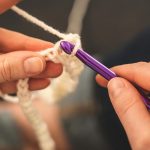In this article, you’ll learn how to repair a tear in your cotton fabric.
Whether it’s a small rip or a larger hole, don’t worry – you can fix it!
We’ll guide you through the process step by step, using simple materials and techniques.
By following our instructions, you’ll be able to mend your fabric and extend its lifespan.
So, let’s get started and restore your cotton fabric to its former glory.
Table of Contents
Understanding the Tear
Understanding the tear is essential to properly repairing cotton fabric. When it comes to fixing a tear, it is crucial to have a clear understanding of the fabric composition and assess the severity of the tear.
Cotton fabric is made from natural fibers derived from the cotton plant, known for its softness, breathability, and durability. However, it is prone to tearing due to its woven structure.
To properly repair a tear in cotton fabric, you first need to assess the severity of the tear. Is it a small, minor tear or a larger, more significant one? This will determine the repair method you should use.
For minor tears, you can use simple sewing techniques like a straight stitch or a zigzag stitch to mend the fabric. However, for larger tears, you may need to patch the area using a matching fabric or using an iron-on adhesive patch.
Understanding the tear and its severity will help you choose the appropriate repair method and ensure a successful outcome. So, take the time to carefully examine the tear and assess its severity before attempting any repairs. This will help you achieve a seamless repair that will restore your cotton fabric to its original state.
Gathering the Necessary Materials
When it comes to repairing tears in fabric, there are a few key points to consider.
First, you will need to gather the essential repair tools, such as a needle, thread, and scissors.
Next, it is important to assess the tear in the fabric to determine the best approach for repair.
Essential Repair Tools
To fix a tear in cotton fabric, you’ll need some essential repair tools. Here are three items you’ll need to successfully mend the tear:
-
Sewing needles: Choose a needle with a sharp point and a large eye to easily thread the cotton thread through. The needle should be strong enough to withstand the tension of the thread and the fabric.
-
Cotton thread: Opt for a thread that matches the color of the fabric to ensure a seamless repair. Cotton thread is ideal for repairing cotton fabric as it provides a strong and durable hold.
-
Thimble: Protect your fingers from the sharp needle with a thimble. This small tool fits over your finger and allows you to push the needle through the fabric without hurting yourself.
Fabric Tear Assessment
Assessing the severity of the tear is crucial in determining the necessary repair method. When assessing the damage to your cotton fabric, start by examining the size and location of the tear. Is it a small, manageable tear or a larger, more extensive one? Consider the impact of the tear on the overall structure and integrity of the fabric.
Next, take a closer look at the edges of the tear. Are they clean and even, or frayed and uneven? This will help determine the type of repair method needed.
Lastly, consider the tear repair options available to you. Depending on the severity of the tear, you may be able to use simple techniques like hand stitching or fabric glue. For more extensive tears, you may need to patch the fabric or seek professional help.
Assessing the damage thoroughly will ensure you choose the most appropriate repair method for your cotton fabric.
Choosing Suitable Materials
Consider the different options available for choosing suitable materials for your project. When it comes to repairing a tear in cotton fabric, it’s important to select the right materials to ensure a strong and durable repair.
Here are three key factors to consider:
-
Suitable thread: Choose a thread that matches the color and weight of the fabric to seamlessly blend in with the surrounding area. A strong and durable thread, such as polyester or cotton-wrapped polyester, is recommended for a long-lasting repair.
-
Repair techniques: Depending on the size and location of the tear, different repair techniques may be suitable. For small tears, you can use a simple hand stitch or a running stitch to secure the edges together. Larger tears may require a patch or a more intricate sewing technique, such as a ladder stitch or a whip stitch.
-
Reinforcement: To ensure the repair holds up well over time, consider reinforcing the area with an iron-on patch or adding a layer of fusible interfacing to strengthen the fabric around the tear.
Preparing the Fabric
Before starting the repair, make sure you’ve thoroughly cleaned the fabric. Proper fabric preparation is crucial to ensure a successful repair. Begin by inspecting the tear size. Is it a small, medium, or large tear? This will determine the necessary steps for preparation.
| Tear Size | Preparation Steps |
|---|---|
| Small | Trim any loose threads around the tear. Gently press the fabric around the tear to smooth it out. |
| Medium | Trim any loose threads and use a needle and thread to secure the edges of the tear with small stitches. Press the fabric to flatten it. |
| Large | Trim any loose threads and use a needle and thread to sew the edges of the tear together. Reinforce the repair with fabric glue or an iron-on patch. Press the fabric to flatten it. |
After addressing the tear size, it’s important to clean the fabric. Follow the care instructions on the fabric label. For cotton fabric, machine wash it on a gentle cycle with mild detergent. Avoid using bleach or harsh chemicals. After washing, air dry the fabric or tumble dry on a low heat setting.
Choosing the Right Repair Method
When it comes to repairing a tear in your fabric, you have a couple of options to consider: sewing or patching.
Sewing involves using a needle and thread to stitch the tear back together, while patching involves applying a separate piece of fabric to cover the tear.
The method you choose will depend on the severity of the tear and your personal preference. Additionally, you’ll need to decide whether you want to sew or patch by hand or use a sewing machine, which can make the process faster and more efficient.
Sewing or Patching
To sew or patch the tear in your cotton fabric, grab a needle and thread and start stitching along the edges. Here are three sewing techniques you can use to repair your fabric:
-
Straight Stitch: This is the most basic sewing technique. Simply insert the needle through the fabric, pull the thread through, and repeat along the tear, creating a straight line of stitches. Make sure to secure the thread at the beginning and end.
-
Backstitch: This technique provides extra strength to your repair. After inserting the needle through the fabric, bring it back one stitch length and insert it through the same hole. Continue this pattern, alternating between forward and backward stitches, until you reach the end of the tear.
-
Zigzag Stitch: This technique is ideal for frayed edges. Start by stitching a straight line along the tear, then sew a zigzag pattern over the straight stitches. This will prevent further fraying and reinforce the repair.
Hand or Machine?
You can choose whether to use a hand or machine for your sewing repairs. Both options have their pros and cons.
Sewing by hand allows for more control and precision. You can carefully stitch the fabric together, ensuring a seamless repair. It is also easier to maneuver in tight spaces or delicate fabrics. However, hand sewing can be time-consuming, especially for larger or more complex repairs.
On the other hand, using a sewing machine can save you time and effort. The machine creates straight and even stitches quickly, making it ideal for larger tears or projects. However, using a machine requires some skill and may not be suitable for delicate fabrics.
Ultimately, the choice between hand and machine sewing depends on the size and complexity of the repair, as well as your personal preference and skill level.
Hand Sewing the Tear
First, grab a needle and thread to sew the tear in your cotton fabric by hand. Hand sewing techniques are essential when repairing delicate fabrics like cotton. Here are three important steps to follow:
-
Prepare the needle and thread: Choose a needle that is appropriate for the fabric weight and a thread that matches the color of the fabric. Thread the needle and tie a knot at the end.
-
Position the fabric: Lay the fabric on a flat surface and align the torn edges as accurately as possible. Hold the fabric firmly in place using your non-dominant hand.
-
Sew the tear: Insert the needle into the fabric, starting from the backside. Take small, even stitches along the tear, making sure to catch both sides of the fabric. Keep the stitches close together to ensure a strong and invisible repair. Continue stitching until you reach the end of the tear.
Remember to sew with precision and take your time to achieve the best results. Hand sewing allows you to have greater control over the repair process, especially when dealing with delicate fabrics like cotton.
Using Iron-On Patches
Using iron-on patches is a quick and convenient way to mend damaged clothing without the need for sewing. If you have a tear in your cotton fabric, iron-on patches offer a simple solution. These patches are made from a material that can be bonded to the fabric using heat from an iron. The process is straightforward and can be done in just a few minutes.
To begin, choose an iron-on patch that matches the color and texture of your fabric. Place the patch over the tear, ensuring that it completely covers the damaged area. Then, set your iron to the appropriate temperature for the fabric and turn off the steam function. Gently press the iron onto the patch, applying even pressure for about 20-30 seconds. Be sure to move the iron around to cover the entire patch.
Once the patch has cooled down, check if it has adhered properly. If there are any loose edges, repeat the ironing process until the patch is securely attached.
Iron-on patches are a great alternative method to traditional sewing, especially if you are short on time or do not have sewing skills. They provide a durable and long-lasting solution for repairing tears in cotton fabric.
Machine Stitching the Tear
Once the iron-on patch has been applied, check the fabric to see if the tear has been securely stitched by the machine. This step is crucial in ensuring that the repair is strong and long-lasting.
Here are some machine stitching techniques to help you achieve the best results:
-
Thread tension: Adjust the tension on your sewing machine to prevent loose or tight stitches. Too loose tension can cause the stitches to unravel easily, while too tight tension can cause the fabric to pucker or tear. Find the right balance by testing on a scrap piece of fabric before stitching the tear.
-
Stitch length: Choose the appropriate stitch length for the fabric you are working with. For cotton fabric, a medium stitch length is usually recommended. Avoid using very long stitches as they may not hold the tear securely, and very short stitches may create unnecessary bulk.
-
Backstitching: Always start and finish your machine stitching with a few backstitches to secure the thread. This will prevent the stitches from coming undone over time. Simply sew a few stitches forward, then sew a few stitches in reverse before continuing with the regular stitching.
Finishing Touches and Care Instructions
To complete the repair, make sure to carefully trim any excess thread and give the fabric a final press to ensure a polished finish.
After stitching the tear, it’s important to take some extra steps to ensure the longevity of your repaired fabric.
First, read and follow the care instructions provided by the manufacturer. These instructions will guide you on how to properly wash, dry, and iron the fabric without causing any damage.
Additionally, to prevent future tears, consider reinforcing the repaired area with a patch or using a fabric glue to secure the edges. This will add extra strength to the weakened spot.
When storing your garment, be mindful of how you fold it to avoid putting unnecessary stress on the repaired area.
If you notice any loose threads or signs of wear, address them promptly to prevent the tear from worsening.
Conclusion
In conclusion, repairing a tear in cotton fabric is a simple process that can save you time and money. By understanding the tear and gathering the necessary materials, you can easily fix the damage. Choosing the right repair method, whether it’s hand sewing, iron-on patches, or machine stitching, is also important. Following the proper steps will ensure a seamless repair. Don’t forget to finish off with some final touches and care instructions to maintain the fabric’s longevity. So don’t panic when you see a tear. With a little effort, your cotton fabric will be as good as new.
- Nonwoven Fabrics: The Definitive Guide for Beginners - July 11, 2025
- Answering the Top Questions About Nonwoven Fabrics - July 11, 2025
- The Science of Nonwoven Fabric: How Fibers Become Fabric - July 11, 2025






